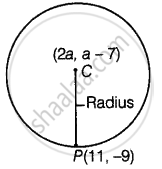Advertisements
Advertisements
Question
The centre of a circle is (2a, a – 7). Find the values of a if the circle passes through the point (11, – 9) and has diameter `10sqrt(2)` units.
Solution
By given condition,
Distance between the centre C(2a, a – 7) and the point P(11, – 9), which lie on the circle = Radius of circle
∴ Radius of circle = `sqrt((11 - 2a)^2 + (-9 - a + 7)^2` ...(i) `[∵ "Distance between two points" (x_1, y_1) "and" (x_2, y_2) = sqrt((x_2 - x_1)^2 + (y_2 - y_1)^2)]`
Given that, length of diameter = `10sqrt(2)`
∴ Length of radius = `"Length of diameter"/2`
= `(10sqrt(2))/2`
= `5sqrt(2)`
Put this value in equation (i), we get
`5sqrt(2) = sqrt((11 - 2a)^2 + (-2 - a)^2`
Squaring on both sides, we get
50 = (11 – 2a)2 + (2 + a)2
⇒ 50 = 121 + 4a2 – 44a + 4 + a2 + 4a
⇒ 5a2 – 40a + 75 = 0
⇒ a2 – 8a + 15 = 0
⇒ a2 – 5a – 3a + 15 = 0 ...[By fractorisation method]
⇒ a(a – 5) – 3(a – 5) = 0
⇒ (a – 5)(a – 3) = 0
∴ a = 3, 5
Hence, the required values of a are 5 and 3.
APPEARS IN
RELATED QUESTIONS
Determine if the points (1, 5), (2, 3) and (−2, −11) are collinear.
In a classroom, 4 friends are seated at the points A, B, C and D as shown in the following figure. Champa and Chameli walk into the class and after observing for a few minutes, Champa asks Chameli, “Don’t you think ABCD is a square?” Chameli disagrees.
Using distance formula, find which of them is correct.

Show that the quadrilateral whose vertices are (2, −1), (3, 4) (−2, 3) and (−3,−2) is a rhombus.
Find the distance between the following pair of point.
P(–5, 7), Q(–1, 3)
Determine whether the points are collinear.
A(1, −3), B(2, −5), C(−4, 7)
Prove that the points (7 , 10) , (-2 , 5) and (3 , -4) are vertices of an isosceles right angled triangle.
The distance between the points (3, 1) and (0, x) is 5. Find x.
The distance between point P(2, 2) and Q(5, x) is 5 cm, then the value of x ______
Find distance between point Q(3, – 7) and point R(3, 3)
Solution: Suppose Q(x1, y1) and point R(x2, y2)
x1 = 3, y1 = – 7 and x2 = 3, y2 = 3
Using distance formula,
d(Q, R) = `sqrt(square)`
∴ d(Q, R) = `sqrt(square - 100)`
∴ d(Q, R) = `sqrt(square)`
∴ d(Q, R) = `square`
A point (x, y) is at a distance of 5 units from the origin. How many such points lie in the third quadrant?
